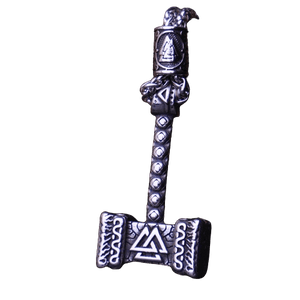Taranis: Between Myth and Reality - The Powerful Celtic Deity Who Still Inspires Today
- min of reading
Summary :

Nordic Wolf Celtic Ring
£26.55

Wolf Head Necklace
£26.55

Celtic Entwined Ring
£30.15

Celtic Triskel Bracelet
£26.55

Viking Rune Ring
£30.15

Celtic Wolf Ring
£26.55

Tree of Life Ring
£26.55

Trique Heart Ring
£26.55

Celtic Ring
£26.55

Celtic Ring
£26.55

Claddagh and Triskel Ring
£26.55
Find out who the famous is: Taranis, a Celtic deity as fascinating as it is complex. Sometimes described as the god of lightning and thunder, Taranis holds an important place in Celtic mythology and continues to inspire minds to this day. But who was Taranis really and what was his role in Celtic culture?
In this article, we will explore the true identity of Taranis by separating myth from reality. We will discover the many facets of this enigmatic deity, from her association with the forces of nature to her influence on war and fertility. We will also examine how Taranis was worshipped and honored by the ancient Celts, and how her legacy still resonates in our modern world today.
Join us as we unveil Taranis, a god whose power and wisdom continue to inspire our collective imagination and amaze us with his complexity.
Click this link or the image below to see our Celtic Ring
The Mythology and Symbolism of Taranis
Celtic mythology is rich with deities and fascinating stories, and Taranis is no exception. In many legends, he is often depicted as the god of thunder and lightning, symbolizing the power of natural forces. However, Taranis ' meaning goes far beyond these simple attributes. According to some interpretations, he was also associated with war and fertility, representing a complex and versatile figure.
Many symbols were associated with Taranis, such as the sun wheel, the hammer, and the shield. These symbols represented her power and authority over the natural elements, as well as her ability to protect and guide the Celts. The myths and legends surrounding Taranis have been passed down from generation to generation, preserving her importance in Celtic culture.
Taranis in ancient Celtic culture and religion
Celtic religion was closely tied to nature and seasonal cycles. Taranis played a central role in this cosmology, representing the brute force of nature and the balance between heaven and earth. He was often invoked in rituals and ceremonies to ensure good harvests, protection from enemies, and prosperity for the community.
Druids, the priests and keepers of Celtic tradition, were responsible for the veneration of Taranis and the interpretation of her divine messages. They performed complex rituals and offerings to honor the god of thunder and lightning. Celtic religion was deeply ingrained in the daily lives of the Celts, and Taranis occupied a central place in their spiritual beliefs and practices.
Click on this link or on the image below to see our Celtic Wolf ring
The representation of Taranis in art and art objects
Celtic iconography offers us a glimpse into the various artistic representations of Taranis. Celtic sculptures, paintings, and artifacts highlight her imposing stature and connection to natural forces. Sun wheels, hammers, and shields are often depicted in these works, symbolizing Taranis' power and ability to control the elements.
Celtic art objects were often decorated with motifs and symbols related to Taranis. These motifs included lightning bolts, clouds, and other elements associated with the natural phenomena he represented. These artistic representations allow us to better understand the importance of Taranis in Celtic culture and the impact he had on society at the time.
The Meaning of Taranis in Modern Culture and Spirituality
Although the ancient Celtic religion has faded, Taranis' influence is still felt in our modern culture and spirituality. Today, many people look to ancient Celtic traditions and seek to connect with Celtic deities, including Taranis. Some see him as a protective and powerful figure, while others are drawn to his association with nature and the elements.
Rituals and practices inspired by Taranis continue to be observed by some groups and communities. These rituals may include invocations, offerings, and celebrations to honor Taranis' power and establish a connection with the forces of nature. For many, these practices are a way to reconnect with their Celtic roots and find spiritual meaning in a modern world that is often disconnected from nature.
Click this link or image to view our Trinity Knot Pendant
Rituals and practices inspired by Taranis
The figure of Taranis has also found its way into contemporary literature and media. Many authors and creators draw inspiration from Celtic mythology and its deities to create captivating stories. Taranis, as the god of thunder and lightning, is often depicted as a powerful and mysterious figure, bringing destruction and rebirth in his wake.
Films, television series, and video games have also used Taranis' image to create epic stories and fantasy worlds. His association with nature and the elements makes him a popular character in fantasy stories, where magic and the supernatural are closely linked.
Taranis' influence on contemporary literature and media
Celtic-inspired festivals and events have become increasingly popular in recent years. They provide an opportunity to celebrate Celtic culture and traditions, including the veneration of Celtic deities such as Taranis . These festivals often include musical performances, traditional dances, rituals and ceremonies to honour Celtic gods and goddesses.
Some festivals place a special emphasis on Taranis by hosting demonstrations of brute force, fire shows, and artistic performances inspired by Celtic mythology. These events offer attendees an immersive experience in the world of Taranis and an opportunity to better understand his importance in Celtic culture.
The Role of Taranis in Celtic-Inspired Festivals and Events
The true nature of Taranis remains a subject of debate among scholars and historians. Historical sources are often fragmentary and contradictory, making it difficult to accurately reconstruct her role and significance in Celtic culture. However, scholars continue to conduct extensive research and offer interpretations based on the evidence we have.
Archaeological discoveries, ancient texts, and comparisons with similar deities in other Celtic cultures provide valuable insights into understanding Taranis. The various theories and interpretations help to broaden our view of this complex deity and shed light on her role in Celtic society.
Revealing the True Nature of Taranis: Historical Research and Interpretations
In conclusion, Taranis remains a fascinating figure in Celtic mythology, whose power and wisdom continue to inspire our imagination and amaze us. Whether as a god of thunder and lightning, or as a symbol of nature and brute strength, Taranis holds an important place in Celtic culture and his legacy resonates to this day.
The veneration and practices inspired by Taranis speak to our ongoing need to connect with nature and the forces that govern it. Her presence in contemporary literature, media, and festivals shows that her power continues to captivate and stimulate our imagination.
Whether we choose to honor Taranis as a Celtic deity or view him as a symbol of natural forces, he remains a powerful reminder of our deep connection to the world around us. Taranis invites us to embrace our own inner strength and find inspiration in the power of nature, while reminding us that we are all connected to an ancestral heritage that continues to shape us today.
Conclusion: Taranis' Enduring Legacy and Its Relevance in Today's World
Taranis is a Celtic deity whose origins date back to the Iron Age. He is often associated with the forces of nature, particularly thunder and lightning. In Celtic mythology, Taranis is depicted as a bearded man carrying a sun wheel in one hand and a lightning bolt in the other. This iconography reflects his role as a god of the sky and the violent elements.
The meaning of the name Taranis is open to interpretation, but many scholars translate it as "thunder" or "sound of thunder." This interpretation reinforces his association with powerful atmospheric phenomena and echoes his reputation as a god of storms and thunderstorms.
Taranis was also known for his close connection with the sun wheel, which symbolized the cycle of the seasons and the movement of the sun across the sky. This association between Taranis and the sun wheel shows his role as a deity connected to time and the cyclical nature of the universe.


































